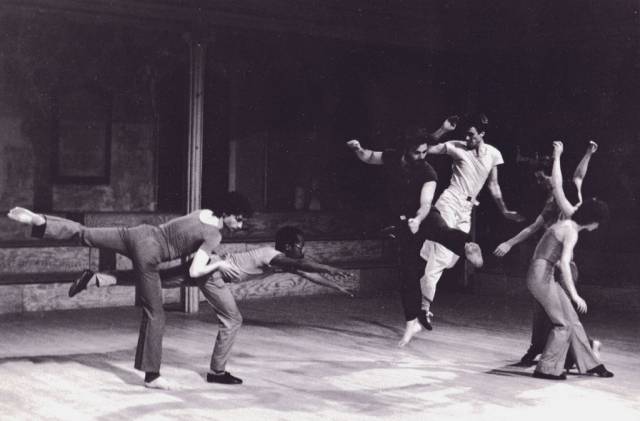

Catherine Galasso’s get dancing was performed as part of the Danspace Project, December 10-12, 2015 at St. Mark’s Church. A revival of choreographic works by Andy de Groat, the concert consists of four dances by de Groat, recreated by Catherine Galasso in conversation with de Groat, her father Michael Galasso (musician to much of de Groat’s repertoire) and former collaborators. The night also featured a new work by Catherine Galasso, and a film by John Meaney and Andy Horn. Performers included original cast members and new dancers alike.
De Groat, known for his minimalistic work, spinning movements, and light humor, has been based in France for the past 30 years; the last time his work was seen in New York was a 1983 presentation of his evening-length Swan Lac at Danspace Project. His name is often tagged onto that of the avant-garde director/playwright Robert Wilson, with whom he collaborated on projects such as Einstein on the Beach (1976).
In get dancing, Galasso has done more than merely revive de Groat’s work. She has created a living archive. The evening opened with Rope Dance Translations, a series of spinning solos, reminiscent of the Whirling Dervishes, with knotted, weighted ropes. The 1974/1979 recreation includes original footage projected onto the upstage wall as well as original performers, Ritty Ann Burchfield, Frank Conversano, and Charles Dennis. A distinguishing quality of de Groat’s work, the utilization of a constant change of direction, can be seen in this piece.
The pieces that followed, get wreck (1978) and fan dance (1978), employ the aforementioned quality on a larger scale. With a cast of dancers that fill the stage, the movement uses little repetition even as it has some consistent qualities, such as the steady beat to which they travel. But with little contextual information, at this point in the concert, we might still be wondering, so what?
Notes on de Groat, a collaborative work by Galasso and dancers Chris DeVita, Kristopher K.Q. Pourzal and Meg Weeks, serves to provide multiple contexts for de Groat’s work, allowing the audience to think back on and retroactively respond to the work already presented, all while enjoying Galasso’s own choreographic response. While listening to Galasso read her notes, which are personal, quirky, and enlightening, we watch the trio (DeVita, Pourzal and Weeks) execute de Groat-inspired choreography and take turns exchanging positions with Galasso herself. Whether dancing or reading, Galasso presents a community-involved process that has been taking place since the beginning of her research and continues to take place, only this time involving the audience.
The evening concludes with an excerpt from Swan Lac to music by the Talking Heads, with the audience now in a position to watch celebratorily, enjoying all the hip swivels and pivot turns that fill the piece as well as the continual changes of direction that we’ve seen throughout. The focus is placed back on de Groat, and we are able to recognize, reflect on and remember his work now recorded in our memories.